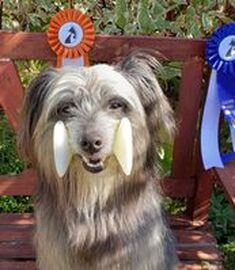 Spy (Denise Bond) Spy (Denise Bond) Dog obedience is one sport that most pet owners will have a passing familiarity to as many are first introduced to the sport when their dogs are young by attending a local training class for obedience. There is, however, a large community of avid dog trainers who compete in the sport of obedience and a closer examination of the sport can show us just how physically demanding the sport of obedience can be for our dogs! In this week blog, I breakdown the sport of obedience, explain what it is, the physical demands it places on our dogs, and how conditioning can play a role in the obedience dog’s performance. What is Obedience?Most pet owners will be familiar with basic obedience which has dogs obey basic commands such as sit, stay, recall, loose leash walking, give/drop it, and lie down. Owners who participate in basic obedience may decide to further their dog’s obedience by participating in competitive obedience training. Dogs in competitive obedience will have an expanded set of commands to learn and be expected to perform behaviours with a higher level of precision than dogs in basic obedience class. Competitive obedience aims to showcase the ability of a dog as a companion animal. The dog will be asked to show a number of behaviours to showcase that the dog is well-behaved in home, in public, and in the presences of other dogs and distractions. Polite on-leash walking, staying, retrieving, and attentiveness to the handler are all important aspects that can be judged during a competition. There are a number of different organizations which offer competitive obedience and many offer similar events. In order to compete in Canadian Kennel Club (CKC) obedience, a dog must be at least 6-months of age and be registered with the kennel club. Obedience competitors work at different levels/classes depending on their own and their dog's experience. In the CKC the different classes are:
Dogs entered into Obedience can be divided into either an A group or a B group. The decision to enter a dog into A or B group will largely depend on past trailing experience. To learn more about CKC obedience rules please see the CKC rulebook. A key part of judging is assessing the dog's willingness or enjoyment of the exercise. Despite the appearance of rigidity, the sport of obedience should be fun for both handler and dog! The Physical Challenges of ObedienceWhile other dog sports can appear to be much more physically demanding than obedience you may be surprised to learn that the obedience dog has their own unique set of physical challenges There are a number of physical challenges to consider for the obedience dog that I’ve narrowed down to four key categories. 1) HeelingWhen training a dog for every day one of the key behaviours we look for is the ability to walk on a leash in a calm and respectful way. In the competitive obedience world, loose leash walking is performed in the ring is called heeling. Heeling is when a handler and dog can really connect with one another in the ring. During this behaviour, handlers and judges, are looking for the dog to walk parallel to the handler on the left side. The dog should be displaying attentiveness and walk with balance and symmetry. There are a couple of key physical challenges that occur during the heeling behaviour. Dog on the Left – In the sport of obedience, heeling is always completed on the left side of the handler. As a result, this can potentially cause one-sided muscle tightness and imbalances, in particular to the musculature of the dog’s neck, shoulder and spine regions. As these R sided muscles tighten, the L side will lengthen. Shorter muscles always create less power and can start a cascade of weakness and compensation issues. Furthermore, if this continues over time, we can see repetitive strain injuries, changes in gait (e.g. shorted stride), increased fatigue, inflexibility and unequal muscle bulk. I will often stress to clients the importance of a well-balanced dog to help mitigate these potential risks. Despite the sport of obedience favouring the left side, it is important that we work both sides of our dogs in other training ventures and activities. This will truly help minimize these potential issues to ensure their left and right side are balanced, flexible and strong to withstand any activity! Pivoting - When pivoting in a heel our dogs are expected to stay in heel position while the handler turns on the spot – usually 90 or 180 degrees. This is deceptively hard for our dogs! The front end will stay stationary while the hind feet will sidestep to get the hind end into position. Your dog will need good rear end awareness and strength, have the ability to sidestep laterally, and be able to shift their weight to the hind end. Change of Pace – During the heel, our dogs will be asked to move at various speeds. Your dog will have to be attentive to pick up on the change of speed and have a strong core to effectively slow down (collect) and speed up without missing a beat. Additionally, your dog will need to be able to maintain position regardless of the speed of the heel. Quick changes of pace are not an easy feat for any dog to handle, but with strength, coordination and a strong core connecting their front and hind end, dogs can make these slow to fast transitions much easier. Tight Turns - Dogs will also be asked to make about-turns (180 degrees) during their heeling exercise. The dog should remain in a close heeling position next to the handler while completing these turns. To maximize this turn and to assist the dog with staying in close proximity to the handler a healthy and flexible spine is key!! Obedience dogs should have excellent spine range of motion that will help to assist in creating a tighter turn. In addition to a flexible spine, having heightened body awareness and strength will help your dog come out of the turn and get immediately back into position. Degree of Neck Extension - If you’ve ever been to an obedience show you may have seen a wide a variety of heeling mechanics or form - some dogs look ahead, some look up at their owners, and others have a more exaggerated head turn with the head held high in a very attentive manner. There will also be variation in the heeling behaviour based on the size and structure of the dog. For heads up heeling, smaller dogs, in particular, will have to hold their head higher than larger breeds to achieve eye contact and focus with the handler. The structure of your dog may even make this style of heel difficult or impossible to achieve without excessive compensation. There is not a one size fits all with the heeling behaviour and much of what you see can be based on what the dog can physically perform (e.g. based on structure and conformation), personal style and preference and training!! Some handlers prefer the heads-up heeling style as it harkens back to high precision drills done in other sports, such as protection, and showcases a dog’s focus on their handler. When the dog’s head is held up the handler can be confident that their dog is fully engaged with them! Heads up heeling definitely has a flash to it but it is certainly not appropriate for all dogs. Without proper training, flexibility and fitness (not to mention certain breeds/types will not be able to do this), this style of heeling can be more physically challenging for the dog as their neck is placed into more extension versus if the dog was looking straight ahead or with a small tilt up. Heads up heeling can also alter the gait mechanics of a dog and impede full extension/reach forward of their shoulders as they tend to engage in increased elbow flexion (e.g. prancing gait). The effects can also be seen in the hind end with reduced stride length causing a blurred vision of balance and symmetry between the front and hind end. Regardless of the style of heel, you want to set your dog up for success and prepare them for the physical demands of this behaviour. To prepare for the challenges of heeling, handlers will have to train and layer the heeling behaviour to build up the dog’s endurance for holding their head up and maintaining their trotting gait throughout. A complimentary conditioning program will help to ensure that all aspects of the dog (front/hind) are strong and flexible to help alleviate any of the physical challenges that arise from various heeling methods. 2) Frequent Changes of PositionOur dog will have to transition between a number of different positions - from sits to downs, to stands, recalls, and finishes. The transition between these positions will need to be done quickly and smoothly. Precision is an important scoring factor in obedience; sloppy form results in fewer points! The better control your dog has over their body the greater their precision and the more efficient their movement! Let’s take a moment and look at one common position your dog will be asked to execute – the sit. In obedience, your dog will also be asked to perform a number of sits during their duration in the ring. Although the sit behaviour may seem like an intuitive behaviour for your dog you want to keep in mind that there is a right way and a wrong way for your dog to sit! In obedience we want our dogs to be able maintain a straight or square sit. This will provide the best biomechanical advantage to your dog and ensure they are balanced, working both their left and right sides of their body evenly. Their hind feet and knees should be tracking forward and nicely tucked in underneath their hips, with both legs equally bent, the spine straight, and no leaning to one side or the other. An “improper” sit is when our dog is sitting with legs splayed out wide or has uneven weight distribution. The dog may slide onto one hip, or have the dog rocked back and sitting on their tail head or rump. There can be a number of reasons why your dog has an improper sit and it may not just be the result of laziness! Common causes of an improper sit may include:
If you notice your dog’s sit is starting to look sloppy or you’re noticing other signs of change in their behaviour or movement then it is likely time to seek out the advice of your health professional. The sooner you can identify and address a physical issue, the quicker it can generally resolve! 3) Whole Body AwarenessDo you know that most dogs carry the majority of their weight in the front end? Our dogs are front-wheel driven with 60 per cent of their weight resting in the front end and 40 per cent in the hind end. Unlike our human counterparts, dogs do not have a collarbone so their shoulder assembly is held together by muscles, tendons, and ligaments. Teaching our obedience dogs to use their whole body is critical for a) avoid overloading the front end potentially causing an injury and b) maximizing the powerhouse of the hind end!! There are a variety of things that can affect your dog and place more focus on their front end. These include age, activity level, arousal level, handler position, reward position, rewarding/reinforcement of forward weight shifting, and slippery floors. Many of the behaviours completed in the obedience ring can be improved by having your dog understand weight shifting to the hind end. Otherwise, we tend to get excessive front-end loading (e.g. pulling from the front) which can be a recipe for disaster if practiced over and over again. Situations, where dogs may rely on front end loading (though not desirable), would include retrieving the dumbbell and turning back towards their handler or improper jumping mechanics when taking a jump. The ability to weight shift and transfer load between front and hind end becomes even more critical during any pivoting motion that we see when a dog completes an about-turn or change in direction. Where should their weight be focused for successful pivoting? If you guessed hind end – you’re right!! It is hard for dogs to pivot well if they are loading their front end! By using their whole body, our dogs become better balanced and more fluent movers! 4) Physical and mental enduranceAn obedience trial can have several runs over the course of a weekend and dogs will need to have both mental and physical endurance to continue to perform throughout the show. Dogs will also be asked to perform behaviours where they hold a sit, down, or stand position for an extended period of time. While working through higher levels of obedience, longer durations of heeling are also required. Obedience dogs are also asked for a lot of focused attention and precise movements which require a keen mental acuity and physical exertion. By having more mental and physical endurance, you can be assured that your dog will perform the same and more effortlessly around the ring at any given time, regardless of the time-lapse in between shows. Remember, that it can also be quite mentally and physically taxing to maintain a smooth and fluid gait throughout the heeling exercises in obedience and requires strength and endurance training to keep their pace and form. Starting with small sessions and gradually building over time can help the muscles prepare for the challenge in training and in the ring. Common Injuries that can OccurObedience dogs can also experience a number of injuries throughout their sport. Some of the more common injuries are...
Remember to always choose the activities your dog does carefully and to find physical activities that are age-appropriate – rushing into a physical challenge before your dog is ready can lead to injury! Conditioning the Obedience DogNow that we know the physical challenges present in the sport of obedience, we can plan a conditioning program to suit. Conditioning of the obedience dog will not only help improve their performance in the sport but also increase their longevity in obedience and reduce their risk of injury. If your dog does obedience you should seriously consider building canine conditioning into your schedule 15-20 minutes 3x a week. There are some incredible benefits to having a canine conditioning program:
StrengthOur obedience dog will need core and muscle strength in order to perform a number of common obedience behaviours. Strengthening of front and hind end muscles and the core will assist in a fluid trotting gait, keep sits straight, and improve our dog’s endurance of a long day of trialing. There are a number of exercises that can improve strength. For example, working with our dogs on cavaletti exercises can be a great way to extend reach and drive which will help the dog achieve a smooth trot. Heeling also requires exceptional core strength to maintain a proper topline. To see how cavaletti's can help your dog check out my YouTube training video on how to train cavaletti's. Balance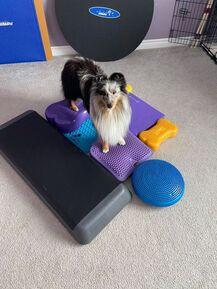 Shades finding balance on different equipment (Carolyn McIntyre) Shades finding balance on different equipment (Carolyn McIntyre) Balance is your dog’s ability to control their body's position, whether stationary or while moving. Balance work will help your dog find their feet when in a stand. A great way to improve balance is to work on unstable equipment. Asking for proper form and positioning on unstable equipment will call into action the core and small stabilizers which aid the larger muscle groups. Balance work will increase our dog's proprioception (body awareness), help your dog move their limbs independently, and have an idea where their hind feet are during pivoting behaviours. Our conditioning program should therefore focus on ensuring there are no muscle imbalances occurring as a result. A favourite exercise to help improve your dog's balance is the random balance exercise. For this exercise, I place a variety of stable (e.g. foam balance pads, plank, wooden platforms) and unstable equipment (human or dog fitness related products) in a random fashion on the ground. The goal of this exercise is to have your dog find balance in irregular positions no matter what their feet are doing. Weight ShiftingWeight shifting to the hind end is hard for dogs especially as dogs are “front wheel” driven. Our dogs will always take the path of least resistance so when they’re off balance they are more likely to shift their weight forward. By teaching weight shifting, we are also offloading their front end and maximizing their power house of the hind end. To teach weight shifting I like to do exercises that have our dog’s front feet elevated such as perch work. Perch work on a disc is also a popular training tool for teaching the pivot in heeling! Have your dog stand on a stool with their front feet elevated. And ask for a small step (in either direction) with either left or right hind foot - start slow and reward for any movement. Front feet should remain on the stool at all times. Deceleration / CollectionCollection is the ability of our dog to slow down. When a dog starts to slow down and engage their core muscles, the core acts as a brake and helps to efficiently slow the dog down without leaving all the braking power to the shoulders. By improving our dog’s shoulder strength or their “brakes” we can assist them in achieving position changes in obedience such as halt and about-turns. Asking our dogs to decelerate and collect is a complex and challenging process within our dog’s body. The muscles during deceleration and collection will need to contract eccentrically (meaning the muscles will lengthen while doing the activity). Eccentric contraction is very fatiguing and our dogs will need to slowly build up strength in order to do it well. A great exercise for improving the shoulder strength in our dogs is an elevated rock back sit. In this exercise, your dog's hind feet are elevated on a piece of equipment (e.g. K9 ramp, K9 bone, balance foam pad) while their front feet remain on the ground. They should start in the standing position and walk their front feet back until they are sitting with their hind end on the equipment of choice. Then have your dog walk back out into the stand while their hind feet remain in position. Turning and FlexibilityFlexibility will greatly help your dog in the ring for their figure eight and about-turn manoeuvres as well as their pivoting. When we talk about flexibility what I’m really referring to is the range of motion of each joint. When our dogs don’t have good flexibility, their tight muscles create less power which in turn increases compensation and can eventually lead to a repetitive strain injury. One of the easiest ways to determine your dog’s flexibility is to perform a few stretching exercises with them. Try having your dog wrap a cone and see if there is a noticeable difference on the left or right side. Do they pass wide one way yet tight the other? You can also have your dog perform cookie stretches to assess flexibility. Have you dog turn their nose into their hip in each direction to see if they can stretch the same distance each way. These tests can also be turned into exercises to help improve flexibility! Cone wrapping is an excellent exercise for body awareness, spine flexibility, and rear-end strengthening. Have you dog chose to circle the cone (they can start in whatever direction they want!!) and turn 180 degrees, reward at your side. Wait for them to go back the other way, again reward by your side. Repeat this exercise 10 times in each direction. In the picture below, I've provided some instruction on how to do cookie stretches with your dog. These stretches actively stretch all four areas of the spine (cervical, thoracic, lumbar, and sacral). How far the dog bends and rotates through their spine will dictate where the stretch is occurring. For example, luring a cookie to your dog's shoulder will primarily stretch their cervical spine. The further back you ask your dog to stretch the more segments of the spine you are stretching! Warm up and Cool DownAs with any sport, it’s incredibly important to ensure your dog is properly warmed up for physical activity and cooled down afterwards. Warming up not only primes our dog’s muscles for work but it also helps to get our dog into the right frame of mind for work. Spending 5-10 minutes prior to your turn in the ring can greatly improve your dog’s connection to you and get them ready to focus on the tasks at hand. Research shows that warm-ups...
The key to a good warm-up is to mimic movements that you dog is about to do in the ring. This will primer their muscles for the work they’re about to do. Warming up your dog is vital and often missed part of your dog’s sporting career. Performing a cool down post work out is also an important part of your dog’s performance. A cool down provides us some focused time to praise and bond with our dogs after working together, cues our dog to relax and settle down, and also restore shortened muscles back to their original length. Both warm-up and cool down take only a short amount of time to do and have massive benefits for prepare your dog for work and reducing their risk of injury. Visit your health professionalAs muscle imbalances can be fairly subtle regular assessments can ensure that any potential imbalance is address quickly before a more serious injury or more apparent issue appears. If you’re noticing a lack of precision in your dog’s movements then it may be time to for a visit to your health professional. Once the underlying issue has been determined you can begin to improve your dog’s precision with targeted exercises, a tailored conditioning program, and re-training. At MCR we advocate for quarterly assessment for all dogs involved in sport. This ensures our dogs are in tip top shape for their sport and also gives us the opportunity to identify subtle differences sooner rather than later. Remember, our dogs aren’t going to pull us aside to say their hurting, instead they’re likely to work through discomfort because they love you and the activities they do. As their training partners we owe it to our dogs to ensure they’re always feeling their best! A final word...Canine conditioning is an excellent complementary activity to do with your obedience dog. Many of the behaviours found in the sport of obedience are also replicated in conditioning exercises. Additionally, canine conditioning can prepare your dog for the mental challenge of obedience training. Remember, that dogs that are both physically and mentally fit are also less likely to experience an injury and can enjoy their sport for longer! If you'd like to learn more about building a unique program for your obedience dog please don't hesitate to reach out to me and learn how I can help! SourcesA special thank you to Alex Robinson for his insight and knowledge as a high level obedience competitor and instructor.
Balckmer, Rachel, "Overview - What's so Important about Deceleration?" (2018) https://fourleg.com/Blog?b=338 Edge-Hughes, Laurie. "Sit Problems in Obedience Competition Dogs," https://www.fourleg.com/media/Sit%20Problems%20in%20Obedience%20dogs.pdf
2 Comments
Joy Hickman
2/5/2021 06:44:00 pm
Excellent article ....love the part about the heads held way up while heeling and the stress & strain it CAN have ....I'm a fan of more natural heeling ....plus the mention of core strength ....very important ....as I have a dog that struggles with this due to GI issues ....and another that has excellent core strength and how well it served her 🙂
Reply
Holly Rhodes
2/6/2021 04:45:35 am
Great article Carolyn!! I have been doing obedience for a few years and beside the strain healing puts on the dog, I never thought about the speed or retrieves as possible problems for my partner! Bad on me. Thanks for the heads up and suggestions on how to improve his strength and coordination
Reply
Leave a Reply. |
AuthorCarolyn McIntyre Archives
June 2024
Categories
All
|

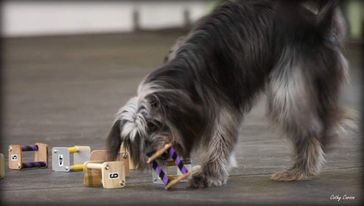
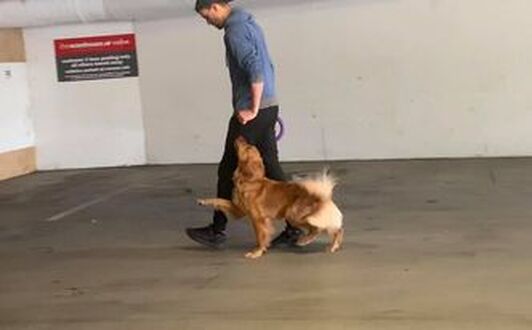
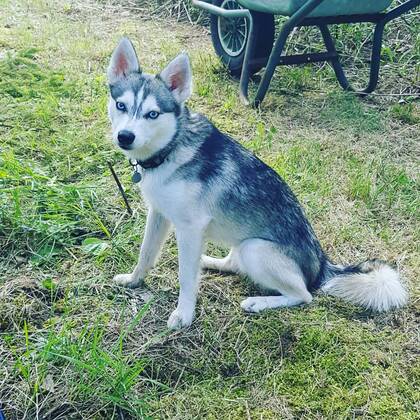
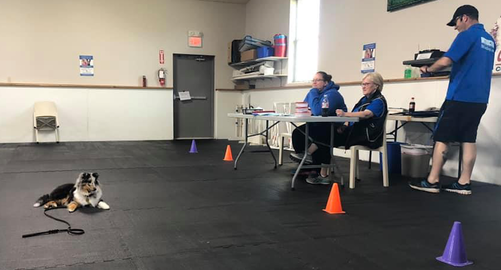
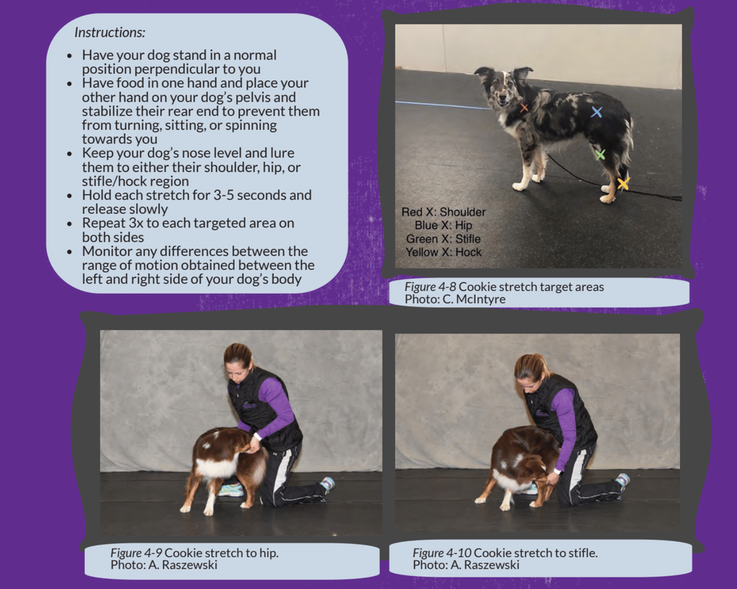
 RSS Feed
RSS Feed